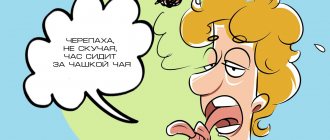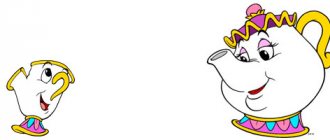Hello, dear readers! In this article I will tell you how the fungus tongue exercise and massage of the speech organs will help you to make some sounds. There comes a time for all children when they start talking. Of course, this is the most important period in speech development. Normally, a child begins to speak at ten months. Diction disorders become more noticeable by the age of two, when the baby tries to find the correct syllables, combining them into words.
If a child is unable to pronounce sounds, syllables, words and phrases correctly, then the cause may be problems in the structure of the organs of articulation, for example, reduced mobility of the tongue. This is where parents should be wary if speech is slurred, hissing sounds and the “r” sound are missing or severely distorted. The baby faces difficulties in communication, spelling, decreased self-esteem and self-confidence.
Short bridle
The reason why a child cannot pronounce a sound is weak muscles of the tongue, cheeks, lips. He has difficulty placing his lips and tongue in the correct position to produce a clear sound. Of course, a common cause of impaired pronunciation of sounds is a shortened hyoid ligament (frenulum). The normal length of the frenulum is one and a half centimeters.
Your dentist may recommend trimming the hypoglossal ligament using a laser or surgery. But it is best to do this in a newborn age, because at the age of 5 - 6 years after healing, a scar remains, which can interfere with speech. Alternatively, try stretching using articulation exercises.
With the help of exercises we will try to stretch the hypoglossal ligament. This is necessary for making the sounds “R” and “L”, as well as other hissing sounds. The effectiveness of the exercises increases if articulatory gymnastics are performed correctly.
Classes are conducted in a well-ventilated, lighted room. The child sits in front of the mirror on a comfortable chair so that his feet reach the floor. At the very beginning, the child and the adult should sit in front of the mirror, the child looks and repeats the movements. When performing the “Mushroom” exercise, the baby should smile and open his mouth wide. Then suck the tongue to the roof of your mouth.
Click your tongue, do the “horse” exercise if it doesn’t work out right away. Then repeat the “mushroom” again. You can support the tongue from below with a spoon, spatula or massage probe. The exercise does not always work out right away, so that the child is not distracted; you can show a picture of mushrooms, tell about them, how they grow, how they are collected, and put in a basket. In the following classes you can tell poems and riddles about fungus. Play collecting toy mushrooms in a box.
Articulation gymnastics.
Articulatory gymnastics is a set of special exercises aimed at strengthening the muscles of the articulatory apparatus, developing strength, mobility and differentiation of movements of the organs involved in the speech process.
The goal of articulatory gymnastics is to develop full-fledged movements and certain positions of the organs of the articulatory apparatus, the ability to combine simple movements into complex ones necessary for the correct pronunciation of sounds. Articulatory gymnastics includes exercises for training the mobility of the organs of the articulatory apparatus, practicing certain positions of the lips, tongue, soft palate, necessary for the correct pronunciation of sounds.
Recommendations:
Play speech therapy exercises in front of the mirror every day; - It is undesirable to perform gymnastics immediately after eating; - an adult monitors the quality and accuracy of the movements performed; - practice for 3-5 minutes every day.
ARTICULATION EXERCISES
"Delicious jam"
Oh, what a pleasure it is to eat cherry jam!
Open your mouth slightly and use the wide front edge of your tongue to lick your upper lip from top to bottom, but not from side to side.
Here is a fungus on a thin stalk - You put it in a basket!
Smile, show your teeth, open your mouth slightly and, pressing your wide tongue with its entire plane to the palate, open your mouth wide. The tongue will resemble a thin cap of a fungus, and the stretched hyoid ligament will resemble the stalk of a mushroom.
Petya and Egor deftly paint the fence with a brush.
Smile, show your teeth, open your mouth slightly and “paint” your lower teeth with the tip of your tongue, move your tongue first from side to side, then from bottom to top. (Upper teeth only).
"Fence"
The little puppy already has big teeth. As Trezorka shows them, Egorka immediately runs into the house.
Smile without tension, so that the front upper and lower teeth are visible. To show your child how to do this, you need to silently pronounce the sound “i”. Hold your lips in this position for a count of 1 to 5.
Our tongue is great! He takes out a lollipop!
1. Glue a piece of candy to the roof of your mouth and remove it with the tip of your tongue. 2. Invite the child to smile, show his teeth, open his mouth and reach for the candy with the tip of his tongue. The lips remain motionless.
"Tube"
We will make a pipe, a pipe - a whistle.
Extend your closed lips forward like a tube. Hold in this position for a count of 5 to 7.
We collect nuts without haste, like a squirrel.
Open your mouth slightly. Alternately press your tongue into your cheeks, simulating squeezing out balls.
Pour water into the barrel - Puff up your cheeks strongly
Close your mouth, press your lips tightly, puff out your cheeks. Rinse your mouth with air.
No need for smiles now - Make your mouth like a fish's.
Lips are compressed, cheeks are drawn in.
"Pancake"
We bake, bake pancakes for both our son and our daughter.
Open your mouth a little, calmly put your tongue on your lower lip and, spanking it with your lips, pronounce the sound combination: “five-five-five.”
"Drum"
Petya got up early today and beats on the drum.
Smile, open your mouth, tap the tip of your tongue behind your upper teeth, while clearly pronouncing the sound; “d-d-d-d...” - slowly at first, then increase the tempo.
"Horse"
Anya and Seryozhka are galloping along the path on horses.
Smile, show your teeth, open your mouth slightly and, sucking your tongue to the roof of your mouth, click the tip of your tongue. Open your mouth wide (like a horse clattering its hooves).
"Watch"
tick-tock, tick-tock - The clock is ticking - That's it!
Open your mouth wide. Slowly move the tongue horizontally from side to side, pulling the tongue towards the corners of the mouth. Alternately change the position of the tongue 4-6 times.
"Swing"
We swung on the swings and smiled at each other!
Smile, show your teeth, open your mouth slightly, put your wide tongue behind your lower teeth on the inside and hold it in this position for a count of one to five, then lift your wide tongue over your upper teeth and hold it for a count of one to five. Alternately change the position of the tongue 4-6 times.
My friend Svetka and I are chewing mints.
Smile, open your mouth slightly, “chew” with your front teeth, wide tip of your tongue.
Friends walking around the yard - Two chatty turkeys.
Open your mouth slightly, place your tongue on your upper lip and move the wide front edge of your tongue along your upper lip back and forth, trying not to lift your tongue from your lip and stroking it. First, make slow movements, then speed up the tempo and add your voice until you hear “bl-bl-bl...”.
I-U, I-U, I-U We took a pipe to kindergarten.
Part your lips in a wide smile, then stretch them forward (“tube”). Alternate movements 6-7 times.
Spread the tongue on the lower sponge like a rug.
Smile, open your mouth slightly, place the wide front edge of your tongue on your lower lip. Hold in this position for a count of 5 to 10.
Hey, my friend, Antoshka! Play the harmonica for us!
Smile, open your mouth slightly, stick your tongue to the roof of your mouth. Without lowering your tongue, open and close your mouth. Lips in a smiling position. When repeating the exercise, you should try to open your mouth wider and wider and keep your tongue in the upper position longer.
How our wizard Nikolka turned a spatula into a needle.
Smile, place your wide tongue on your lower lip, then make your tongue narrow and the tip of your tongue sharp.
Lida, Olya and Natasha drank milk from a cup.
Smile, open your mouth slightly, stretch your tongue forward, bend the tip of your tongue upward.
In the morning we brush our teeth, We love songs and jokes.
Run the tip of your tongue over your upper and lower teeth. Make 5 movements from right to left and left to right.
"Painter"
A gnome painted the ceiling and invites us into his house.
Smile, open your mouth, “stroke” the hard palate with the tip of your tongue, making movements back and forth.
Our steamer floats quickly along the river and hums - “yyyy”!
Open your mouth slightly and pronounce the sound “yyyyyy” for a long time - imitation of a steamship whistle. Draw the child's attention that the wide tip of the tongue is pressed to the palate and does not move.
All children must brush their teeth thoroughly.
Lick your teeth outside and inside, 3-5 movements in each direction.
The tongue is playing hide and seek - Play with it, guys!
Smile, open your mouth slightly, extend your tongue between your teeth as far as possible, and quickly remove it inside your mouth. Repeat 5-6 times.
I dig a hole with a spatula, I embroider flowers with a needle.
Smile, place your wide tongue on your lower lip, then make your tongue narrow and the tip of your tongue sharp.
The swallow feeds the chicks - Vocal fellows.
Lower and raise the lower jaw.
Yulia quickly ate the bagel and wanted strawberries.
Round your lips as when pronouncing the sound “o”. Then imitate grasping a strawberry with your lips.
“Pussy is angry”, “Gorka”. Murka arches his back, squints his eyes and yawns.
Smile, open your mouth slightly. Press the tip of your tongue against your lower teeth, arching the back of your tongue.
Kitty is angry with Masha: She wants fish, not porridge.
Smile, open your mouth slightly. Press the tip of your tongue against your lower teeth, while raising and lowering the back of your tongue.
This round spool is Thread's faithful friend. The mouth is open. The tip of the tongue rests on the lower incisors, the lateral edges are pressed against the upper molars. The wide tongue rolls forward and retracts deep into the mouth.
"Cup"
Our tongue has grown wiser. He managed to make a cup. You can pour tea there. And drink it with sweets.
The mouth is wide open. The anterior and lateral edges of the wide tongue are raised, but do not touch the teeth.
All rights to all text and graphic materials posted on the site belong to the site owners and are protected by copyright law. Copying, reproduction, republication or any other use of any materials posted on the site is prohibited
Source
"Mushroom" with passion
Sometimes this will take quite a long time; unfortunately, not everyone has enough pictures. There are overly active children who are unable to sit and do the exercise. They get bored. You can try making “Mushroom” at home using game techniques. Make up a fairy tale. Put on a puppet show using cocktail umbrellas, for example.
Show a cartoon about a fungus. Every parent knows what their child loves. Take advantage of this, get interested, outwit and try to repeat the exercise.
The “Mushroom” exercise is the most effective in stretching the hyoid frenulum. It is important to do it correctly and regularly.
Before performing the “Mushroom” exercise, do a short warm-up for your tongue. The process will become more fun and interesting by telling a fairy tale.
The Tale of Little Mushroom
Once upon a time there lived a small mushroom in a pine forest. And he really wanted to grow up quickly, but didn’t know how. There were rumors in the forest about the old and wise old man Borovichka. The fungus went on a search. For several days and nights he walked through the forest, asking all the mushrooms he encountered along the way. Unfortunately, no one knew where the old man lived. Coming out to the edge of the forest, an old man named Borovichok sat near a tall spruce tree on the sun-warmed grass.
Mushroom was delighted and ran as fast as he could towards him. Mushroom asked how he could grow up faster. The old man frowned, became thoughtful and said: “With the first warm rain you will begin to grow.” First, your cap will stretch upward, and then your leg will begin to stretch out and grow.” Mushroom thanked the old man and went home. As Borovichok said, with the first warm rain the Fungus began to grow and grew into a large beautiful boletus.
Using a fairy tale as an example, show your child the “Mushroom” exercise. Only the tip of the tongue is a cap. The mushroom stalk is the sublingual ligament.
Massage of the hypoglossal ligament
In order to quickly stretch the ligament, massage under the tongue is required. Sequence of massage:
- Open the baby's mouth;
- Pull out your tongue and place it on your upper lip so that the frenulum is visible.
- Cover your tongue with a handkerchief, holding it with your fingers, and with your other hand (index finger and thumb) slide along the frenulum in different directions with stretching movements.
You can massage using massage probes or attachments.
The problem of pronunciation of sounds in children of preschool and school age always remains relevant. Therefore, how a child speaks correctly in the future is entirely the responsibility of the parents. Speech therapy knowledge will help overcome disorders and correct speech. Be sure to repeat the exercise at home, and your baby will quickly learn to speak correctly.
Subscribe to our blog, there are many more interesting articles that everyone should read. Take care of your children and all the best!
Here are other articles with more detailed descriptions of the exercises: cup horse accordion delicious gymnastics lip exercises standard gymnastics
Learning to pronounce the sound R correctly
“Lyba”, “fabaka”, “detective”! What a joy it is for children who do not yet know how to correctly pronounce all the sounds of oral speech. True, it is not always worthwhile to be touched by such a “special” pronunciation of sounds. If your child is already 4-5 years old and still does not know how to speak correctly and expressively, you should pay special attention to this and consult a speech therapist.
How does mastery of sound pronunciation occur normally?
To develop correct sound pronunciation in a child, it is necessary to form full-fledged movements of his articulatory organs.
Typically, a child’s mastery of high-quality pronunciation of all speech sounds occurs before the senior preschool age and occurs spontaneously in the process of imitating the articulatory movements of people around him and controlling himself. If, under natural conditions, a child finds it difficult to master this complex process, he should seek professional help from a speech therapist teacher. At the same time, parents themselves can help their child learn to pronounce this or that sound correctly.
One of the most common violations of sound pronunciation is the distorted pronunciation of the sound R or its replacement with other sounds. In this article we will introduce you to articulatory gymnastics exercises that contribute to the appearance and correction of defective pronunciation of a given sound.
General rules for organizing work on evoking sounds
Depending on the sound defect, a complex of articulatory gymnastics is used, which differ from each other in type characteristics and duration. All presented characteristics of articulation exercises must correspond to the individual characteristics of each particular child, and also be appropriate at a specific stage of speech therapy work.
So, in the first lessons with your baby, you can limit yourself to two repetitions of the exercises. This is due to increased exhaustion of the tongue muscles, which are directly targeted by articulation exercises. In the future, the number of repetitions can be increased. At the same time, the requirements for the quality of articulatory movements are increasing, which must be more accurate, clean, smooth and stable.
A complex of articulatory gymnastics to prepare the speech apparatus for the correct pronunciation of the sound R
Exercise “Brush your teeth.” Open your mouth wide. The upper and lower teeth should not be visible. Use the tip of your tongue to move from side to side on the inside of your upper teeth. When performing the exercise, only the tongue works, which should not protrude from the mouth or bend in any way.
Exercise "Painter". Lips in a smile. The lower jaw and lips are motionless. Use the tip of your tongue to move back and forth across the hard palate (imitating stroking).
Exercise “Delicious jam”. Open your mouth slightly. Stick out your wide tongue, the edges of which should touch the corners of your mouth. Then perform licking actions with your tongue around your mouth. Only the tongue works. The lower jaw remains motionless.
Exercise "Turkey". Open your mouth a little. Place a wide tongue on your upper lip. Then move your tongue back and forth across your upper lip (imitating stroking). Add a voice to make the sound combination “bl”.
Exercise "Drummers". Open your mouth slightly. Raise the tip of the tongue up and perform tapping movements on the upper alveoli. In parallel with these movements with the tongue, add a voice to create a distinct sound D. As a result of such repeated actions, the shocks of the air stream should be felt.
When repeated many times, the presented set of exercises will help strengthen the muscles of the tongue, and most importantly, prepare the entire articulatory apparatus for the production and correction of defective pronunciation of the sound R.









